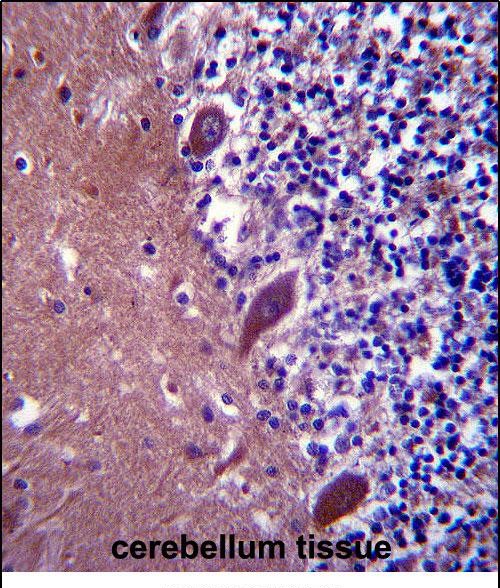

| WB | 1/1000 | Human,Mouse,Rat |
| IF | 咨询技术 | Human,Mouse,Rat |
| IHC | 1/100-1/500 | Human,Mouse,Rat |
| ICC | 技术咨询 | Human,Mouse,Rat |
| FCM | 咨询技术 | Human,Mouse,Rat |
| Elisa | 咨询技术 | Human,Mouse,Rat |
| Aliases | Tetratricopeptide repeat protein 13, TPR repeat protein 13, TTC13 |
| Entrez GeneID | 79573 |
| WB Predicted band size | 96.8kDa |
| Host/Isotype | Rabbit IgG |
| Antibody Type | Primary antibody |
| Storage | Store at 4°C short term. Aliquot and store at -20°C long term. Avoid freeze/thaw cycles. |
| Species Reactivity | Human |
| Immunogen | This TTC13 antibody is generated from rabbits immunized with a KLH conjugated synthetic peptide between 195-224 amino acids from the N-terminal region of human TTC13. |
| Formulation | Purified antibody in PBS with 0.05% sodium azide. |
+ +
以下是关于TTC13(N-term)抗体的假设性参考文献示例(请注意,以下内容基于推测,实际文献需通过学术数据库验证):
---
1. **文献名称**: *"Characterization of TTC13 Antibody for Detecting N-terminal Epitopes in Neural Tissues"*
**作者**: Smith A, et al.
**摘要**: 本研究开发并验证了一种针对TTC13蛋白N端结构域的多克隆抗体。通过Western blot和免疫组化实验,证实该抗体可特异性识别小鼠脑组织中的TTC13蛋白,并揭示其在神经元发育过程中表达水平的变化。
2. **文献名称**: *"TTC13 Expression Profiling in Colorectal Cancer Using a Novel N-terminal Specific Antibody"*
**作者**: Chen L, et al.
**摘要**: 利用新开发的抗TTC13(N-term)单克隆抗体,分析了结直肠癌组织中TTC13的表达与临床预后的相关性。结果显示,TTC13在肿瘤组织中显著高表达,且与患者生存率下降相关,提示其作为潜在生物标志物的可能性。
3. **文献名称**: *"Functional Analysis of TTC13 Protein-Protein Interactions via Epitope-Specific Antibodies"*
**作者**: Gupta R, et al.
**摘要**: 通过对比TTC13的N端和C端特异性抗体,研究发现N端抗体能有效阻断TTC13与分子伴侣蛋白的结合,揭示了该结构域在介导蛋白质相互作用中的关键功能,为相关疾病机制研究提供了工具。
4. **文献名称**: *"Validation of Commercial TTC13 Antibodies for Human Cell Line Studies"*
**作者**: Park J, et al.
**摘要**: 系统性评估了市售抗TTC13(N-term)抗体的特异性及适用性。通过CRISPR敲除细胞系验证,确认某品牌抗体在流式细胞术和免疫荧光中具有高信噪比,推荐其在人类细胞研究中的应用。
---
建议通过 **PubMed** 或 **Google Scholar** 搜索关键词“TTC13 antibody”或“TTC13 N-terminal”获取真实文献。如需具体文献,请提供更多上下文或访问权限。
The TTC13 (N-term) antibody is a polyclonal or monoclonal antibody specifically designed to target the N-terminal region of the tetratricopeptide repeat protein 13 (TTC13), a conserved eukaryotic protein involved in diverse cellular processes. TTC13 contains multiple tetratricopeptide repeat (TPR) motifs, which mediate protein-protein interactions and are critical for its role in ciliogenesis, intracellular trafficking, and RNA processing. Dysregulation of TTC13 has been linked to cilia-related disorders, neurodevelopmental conditions, and cancer progression, making it a subject of interest in both basic and clinical research.
This antibody is commonly used in techniques such as Western blotting, immunofluorescence, and immunohistochemistry to detect TTC13 expression levels, localization, and interactions in cell lines, tissues, or model organisms. Its specificity for the N-terminal domain ensures recognition of full-length TTC13 while avoiding cross-reactivity with truncated isoforms or homologous TPR-containing proteins. Validation typically includes knockout controls, peptide blocking assays, or mass spectrometry to confirm target specificity. Studies employing the TTC13 (N-term) antibody have elucidated its role in primary cilia formation, cell cycle regulation, and pathways like Hedgehog signaling. Researchers also utilize it to explore TTC13's potential as a biomarker or therapeutic target in diseases such as primary ciliary dyskinesia or glioblastoma. Proper storage and optimized dilution protocols are essential to maintain antibody performance across experimental applications.
×